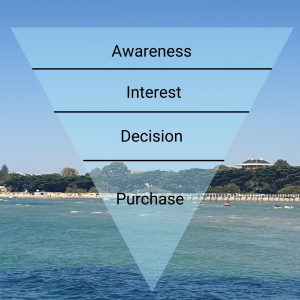If you’ve read our recent article on setting the right digital marketing goals, you’ll have noticed that we talk about the sales funnel. But what is a sales funnel and how does it help you better understand your online marketing efforts?
Put simply, a sales funnel is a representation of a person’s journey from discovering your product to making a decision to purchase it. Even very simple purchasing decision go through a decision making process or funnel.
While there’s slightly different definitions of a sales funnel’s steps, they’re all pretty synonymous and generally go along the lines of:
 Awareness: generally becoming aware that a product or service exists.
Awareness: generally becoming aware that a product or service exists.- Interest: realising that the product or service may be useful to you.
- Decision: deciding that this is the right product/service for you. This may involve researching the product itself or comparing it to competitors.
- Purchase: actually buying the product or service.
How Does The Sales Funnel Work
Let’s go through two examples: one where a customer is looking for a specific product and one where the product is more novel and it needs to be shown to the customer.
A Customer Looking For An Electrician
Let’s say you’re an electrician serving Frankston and surrounds. If people in the area need a sparky, they’ll search for it. With this in mind, running some Google Ads may be a good idea.
- Awareness: the users searches for something like “electrician Frankston” and your ad appears in a group of ads at the top of the page.
- Interest: your ad has a great headline noting that you’re local and provide free quotes. You’re now on the short list.
- Decision: your website has great user experience and has a number of testimonials from happy customers and is optimised for mobile (since the user is probably searching on mobile).
- Purchase: after comparing your electrician service to others, yours looks the most reputable so they give you a call.
Sure, a lot of users will just click on the first ad and give it a go, but they’re still moving through those steps. Or they call a few and get different quotes; that’s still decision/research/purchase.
Selling Hand Made Candles To Customers Looking For Gifts
Retail businesses can appeal both to users buying for themselves and as gifts. A lot of more artisanal goods, like candles and other crafts, make good gifts. The key to finding gift buyers is to target them correctly.
While a larger strategy can get users to your website, we’ll concentrate on advertising on Facebook and Instagram. Here you can target users by age, gender, and whether they have a good gift giving occasion coming up (like having a friend with a birthday soon).
The buying decision follows the same steps:
- Awareness: the user sees the ad for hand made candles.
- Interest: since you’re targeting gift givers, the copy of your ad would reflect this. The user will think about a friend who may like a candle as a gift.
- Decision: as more of an impulse purchase, the user goes straight to the site to check prices and to see what’s available.
- Purchase: happy with the selection, they make a purchase as a gift for their friend.
Some users may shop around for another gift for their friend so get stuck in the “interest” phase of the sales funnel. That’s OK, not all buying journeys are instantaneous like the above.
What About Larger Purchases That Take Longer?
For larger purchases, the interest and decision making process may be longer and take more nurturing. And this makes sense.
A digital marketing agency such as ours is the type of service that would have a longer sales funnel.
Potential clients may be considering hiring an agency but may need to be nurtured and given reasons to go with an agency. Furthermore, ours is a relationship based business. While we do one off projects, they’re not a quick transaction, so clients want to know they’re making the right choice.
Nurturing can happen in a lot of ways. From newsletters, to social media, to content. Of course this doesn’t discount good old relationship building and working with potential clients.
We’ve talked about it before, but going straight for the sale isn’t always the way to go. Think about where in the sales funnel you need to target, go for it, and move the customer to the next point in the buying journey.
